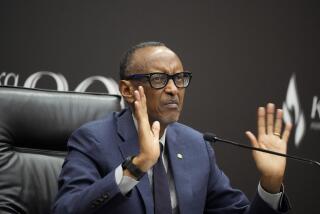New Rwanda Leaders Make Plea for Unity : Africa: Officials of both ethnic groups appear before crowd. Whether they can end rivalry is unknown.
- Share via
BUTARE, Rwanda — From the rolling green hills surrounding Rwanda’s second-largest city, thousands of peasants walked to the Huye soccer stadium Saturday for their first glimpse of the country’s new leaders.
The people perched on the stadium’s crumbling walls and sat on the rough brown grass of the playing field as hawks circled overhead. It was cool and cloudy as the meeting began, and many people took shelter under umbrellas.
Interior Minister Seth Sendashonga, his baritone amplified by two loudspeakers, told the audience, “If you agree to construct unity in the country, put up your hands.”
Thousands of hands shot up. Hutus raised theirs, and Tutsis raised theirs.
That pledge of tolerance by Butare’s people may have been motivated by hope, the desire to conform or fear about what lies ahead.
Only the coming months and years will show whether a new Rwanda can be constructed and the deadly rivalry between the country’s two largest ethnic groups put to rest.
The past has been a disaster; the present is very bleak.
The new prefect of the Butare region, a young man named Zigara, told the crowd of 4,000 that “the general situation is catastrophic.”
“This spring’s orgy of ethnic murder has left countless orphans, widows and widowers,” Zigara said. In the Central African country that called itself “the land of eternal spring” in travel brochures, “there is a danger of famine,” he said. Many of the banana groves and farm fields are eerily empty.
According to the latest estimates by U.N. officials handling emergency relief to Rwanda, almost 2 million people, many of them Hutus who planned and carried out the slaughter of Tutsis and moderate Hutus, are hunkered down in foreign refugee camps. Hundreds of thousands have left their homes and are living elsewhere in Rwanda.
One million people, an eighth of Rwanda’s population at the beginning of this year, are believed to have died.
“We should do everything so that it doesn’t start again,” said Vice President and Defense Minister Paul Kagame, a Tutsi who led the Rwandan Patriotic Front to victory in a three-month war against a Hutu-dominated government.
“What’s done is done--people should think about the future,” Kagame said. “There are people who want to use the military to carry out acts of revenge. But people must understand that the military waged war and that now it is over.”
Small bands of the old government army are still armed and scattered in Rwanda’s southwest, U.N. officials said Friday.
And Rwanda’s new leaders clearly fear counterattack or insurgency. From here to Kigali, the capital, young men from Kagame’s forces were placed about 100 feet apart on the roadside Saturday. As the new leaders trundled into Huye stadium aboard four all-terrain vehicles, former members of the guerrilla army sprinted onto the field to stand guard.
During the rally, Cabinet members were paraded onto the field to show that the new government is made up of both Hutus and Tutsis.
“Everybody should get together; everybody should help each other,” said Prime Minister Faustin Twagirimungu, a Hutu. “There is no difference between a Hutu peasant and a Tutsi peasant.”
More to Read
Sign up for Essential California
The most important California stories and recommendations in your inbox every morning.
You may occasionally receive promotional content from the Los Angeles Times.













